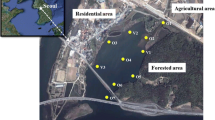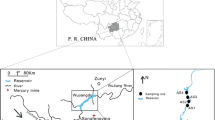Abstract
Lake Changpo (LC) is an artificial freshwater lake surrounded by wetlands and farmlands, inundated with water during the wet season, on the southwest coast of Korea. To investigate the temporal and spatial distribution of total mercury (THg) and methylmercury (MeHg) in LC and adjacent Cheonggye Bay (CB), water and sediment samples were collected five times from August 2009 to August 2010. In addition, fish samples were collected to examine Hg levels. The THg concentration in the unfiltered water of LC ranged from 1.6 to 5.0 ng/L and had a positive relationship with total suspended solids (TSS). This positive relation indicates that TSS is an important source of THg in LC. The MeHg levels were highest during August and ranged from 0.03 to 0.19 ng/L in unfiltered water and from 0.01 to 0.10 ng/L in filtered water. Both the THg and MeHg levels in the sediments were significantly correlated with the organic matter content of the sediments. Overlapping of the spatial and temporal distribution patterns of MeHg and %MeHg between the water column and sediments suggests that production and diffusion of MeHg from the sediment, particularly during warm summer, was the primary source of MeHg in the water column. In addition, higher THg and MeHg concentrations were found in catfish, a bottom-dweller fish. Thus, the higher THg and MeHg concentrations in LC compared to CB demonstrate that artificial lakes could be a significant site for Hg methylation and an additional source of MeHg to coastal seas.
Similar content being viewed by others
References
Adams JB, Romdalvik J, Ramanujam VS, Legator MS (2007) Mercury, lead, and zinc in baby teeth of children with autism versus controls. J Toxicol Env Health 70(12):1046–1051
Babiarz CL, Benoit JM, Shafer MM, Andren AW, Hurley JP, Webb DA (1998) Seasonal influences on partitioning and transport of total and methylmercury in rivers from contrasting watersheds. Biogeochemistry 41(3):237–257
Balcom PH, Hammerschmidt CR, Fitzgerald WF, Lamborg CH, O'Connor JS (2008) Seasonal distributions and cycling of mercury and methylmercury in the waters of New York/New Jersey Harbor Estuary. Mar Chem 109(1):1–17
Balogh SJ, Meyer ML, Johnson DK (1996) Mercury and suspended sediment loadings in the lower Minnesota River. Environ Sci Technol 31(1):198–202
Benoit J, Gilmour C, Heyes A, Mason R, Miller C (2003) Geochemical and biological controls over methylmercury production and degradation in aquatic ecosystems. ACS Sym Ser 835:262–297
Benoit JM, Mason RP, Gilmour CC (1999) Estimation of mercurysulfide speciation in sediment pore waters using octanol— water partitioning and implications for availability to methylating bacteria. Environ Toxicol Chem 18(10):2138–2141
Bloom NS, Gill GA, Cappellino S, Dobbs C, McShea L, Driscoll C, Mason R, Rudd J (1999) Speciation and cycling of mercury in Lavaca Bay, Texas, sediments. Environ Sci Technol 33(1):7–13
Campbell LM, Balirwa J, Dixon D, Hecky R (2004) Biomagnification of mercury in fish from Thruston Bay, Napoleon Gulf, Lake Victoria (East Africa). Afr J Aquat Sci 29(1):91–96
Cardona-Marek T, Schaefer J, Ellickson K, Barkay T, Reinfelder JR (2007) Mercury speciation, reactivity, and bioavailability in a highly contaminated estuary, Berry’s Creek, New Jersey Meadowlands. Environ Sci Technol 41(24):8268–8274
Chakraborty P, Sarkar A, Vudamala K, Naik R, Nath BN (2015) Organic matter—a key factor in controlling mercury distribution in estuarine sediment. Mar Chem 173:302–309
Chasar LC, Scudder BC, Stewart AR, Bell AH, Aiken GR (2009) Mercury cycling in stream ecosystems. 3. Trophic dynamics and methylmercury bioaccumulation. Environ Sci Technol 43(8):2733–2739
Choe KY, Gill GA (2003) Distribution of particulate, colloidal, and dissolved mercury in San Francisco Bay estuary. 2. Monomethyl mercury. Limnol Oceanogr 48(4):1547–1556
Compeau GC, Bartha R (1987) Effect of salinity on mercurymethylating activity of sulfate-reducing bacteria in estuarine sediments. Appl Environ Microb 53(2):261–265
Conaway CH, Squire S, Mason RP, Flegal AR (2003) Mercury speciation in the San Francisco Bay estuary. Mar Chem 80(2):199–225
EPA (2002) Method 1631, Revision E: mercury in water by oxidation, purge and trap, and cold vapor atomic fluorescence spectrometry. US Environmental Protection Agency Washington DC, EPA-821/R-02/019
Graydon JA, Emmerton CA, Lesack LF, Kelly EN (2009) Mercury in the Mackenzie River delta and estuary: concentrations and fluxes during open-water conditions. Sci Total Environ 407(8):2980–2988
Guentzel JL (2009) Wetland influences on mercury transport and bioaccumulation in South Carolina. Sci Total Environ 407(4):1344–1353
Gustin MS, Saito L, Peacock M (2005) Anthropogenic impacts on mercury concentrations and nitrogen and carbon isotope ratios in fish muscle tissue of the Truckee River watershed, Nevada, USA. Sci Total Environ 347(1):282–294
Hall B, Aiken G, Krabbenhoft D, Marvin-DiPasquale M, Swarzenski C (2008) Wetlands as principal zones of methylmercury production in southern Louisiana and the Gulf of Mexico region. Environ Pollut 154(1):124–134
Hammerschmidt CR, Fitzgerald WF (2004) Geochemical controls on the production and distribution of methylmercury in nearshore marine sediments. Environ Sci Technol 38(5):1487–1495
Honeyman B, Santschi P (1989) A Brownian-pumping model for oceanic trace metal scavenging: evidence from Th isotopes. J Mar Res 47(4):951–992
Horvat M, Bloom NS, Liang L (1993) Comparison of distillation with other current isolation methods for the determination of methyl mercury compounds in low level environmental samples: part 1. Sediments. Anal Chim Acta 281(1):135–152
Ikingura J, Akagi H (2003) Total mercury and methylmercury levels in fish from hydroelectric reservoirs in Tanzania. Sci Total Environ 304(1):355–368
Jin L, Liang L, Jiang G, Xu Y (2006) Methylmercury, total mercury and total selenium in four common freshwater fish species from Ya-Er Lake, China. Environ Geochem Hlth 28(5):401–407
Kim H, Noh S, Kim E, Poopal RK, Lee HY, Han S (2011) Bioconcentration of methylmercury in microzooplankton in a temperate river. Environ Toxicol Chem 30(12):2860–2867
King JK, Kostka JE, Frischer ME, Saunders FM (2000) Sulfatereducing bacteria methylate mercury at variable rates in pure culture and in marine sediments. Appl Environ Microb 66(6): 2430–2437
Kongchum M, Devai I, DeLaune R, Jugsujinda A (2006) Total mercury and methylmercury in freshwater and salt marsh soils of the Mississippi river deltaic plain. Chemosphere 63(8): 1300–1303
Kotnik J, Horvat M, Fajon V, Logar M (2002) Mercury in small freshwater lakes: a case study: Lake Velenje, Slovenia. Water Air Soil Poll 134 (1–4):317–337
Lacerda L, Gonçalves G (2001) Mercury distribution and speciation in waters of the coastal lagoons of Rio de Janeiro, SE Brazil. Mar Chem 76(1):47–58
Lambertsson L, Nilsson M (2006) Organic material: the primary control on mercury methylation and ambient methyl mercury concentrations in estuarine sediments. Environ Sci Technol 40(6):1822–1829
Lee H, Ryu S (2007) Role of the giant Saemangeum dyke in sedimentation at the mouth of an estuarine complex. Mar Geol 239(3–4):173–188
Lee YG, An KG, Ha PT, Lee KY, Kang JH, Cha SM, Cho KH, Lee YS, Chang IS, Kim KW (2009) Decadal and seasonal scale changes of an artificial lake environment after blocking tidal flows in the Yeongsan Estuary region, Korea. Sci Total Environ 407(23):6063–6072
Li S, Zhou L, Wang H, Liang Y, Hu J, Chang J (2009) Feeding habits and habitats preferences affecting mercury bioaccumulation in 37 subtropical fish species from Wujiang River, China. Ecotoxicology 18(2):204–210
Mason RP, Lawrence AL (1999) Concentration, distribution, and bioavailability of mercury and methylmercury in sediments of Baltimore Harbor and Chesapeake Bay, Maryland, USA. Environ Toxicol Chem 18(11):2438–2447
Mason RP, Reinfelder JR, Morel FM (1996) Uptake, toxicity, and trophic transfer of mercury in a coastal diatom. Environ Sci Technol 30(6):1835–1845
Moreno FN, Anderson CW, Stewart RB, Robinson BH (2005) Mercury volatilisation and phytoextraction from base-metal mine tailings. Environ Pollut 136(2):341–352
Nevado JB, Martín-Doimeadios RR, Bernardo FG, Moreno MJ, Ropero MP, de Marcos Serrano A (2011) Mercury speciation in fish tissues from a Mediterranean River basin: the Tagus River (central Spain) as a case study. Arch Environ Con Tox 61(4):642–652
Nguyen H, Leermakers M, Kurunczi S, Bozo L, Baeyens W (2005) Mercury distribution and speciation in Lake Balaton, Hungary. Sci Total Environ 340(1–3):231–246
Oh S, Kim M-K, Yi S-M, Zoh K-D (2010) Distributions of total mercury and methylmercury in surface sediments and fishes in Lake Shihwa, Korea. Sci Total Environ 408(5):1059–1068
Pacyna EG, Pacyna JM, Steenhuisen F, Wilson S (2006) Global anthropogenic mercury emission inventory for 2000. Atmos Environ 40(22):4048–4063
Pak KR, Bartha R (1998) Mercury methylation and demethylation in anoxic lake sediments and by strictly anaerobic bacteria. Appl Environ Microb 64(3):1013–1017
Park JS, Oh S, Shin M-Y, Kim M-K, Yi S-M, Zoh K-D (2008) Seasonal variation in dissolved gaseous mercury and total mercury concentrations in Juam Reservoir, Korea. Environ Pollut 154(1):12–20
Park JS, Lee JS, Kim GB, Cha JS, Shin SK, Kang HG, Hong EJ, Chung GT, Kim YH (2010) Mercury and methylmercury in freshwater fish and sediments in South Korea using newly adopted purge and trap GC-MS detection method. Water Air Soil Poll 207(1–4):391–401
Ramalhosa E, Segade SR, Pereira E, Vale C, Duarte A (2006) Mercury cycling between the water column and surface sediments in a contaminated area. Water Res 40(15):2893–2900
Ravichandran M (2004) Interactions between mercury and dissolved organic matter–a review. Chemosphere 55(3):319–331
Rolfhus K, Sakamoto H, Cleckner L, Stoor R, Babiarz C, Back R, Manolopoulos H, Hurley J (2003) Distribution and fluxes of total and methylmercury in Lake Superior. Environ Sci Technol 37(5):865–872
Turner A, Millward GE, Le Roux SM (2004) Significance of oxides and particulate organic matter in controlling trace metal partitioning in a contaminated estuary. Mar Chem 88 (3):179–192
Ullrich SM, Tanton TW, Abdrashitova SA (2001) Mercury in the aquatic environment: a review of factors affecting methylation. Crit Rev Env Sci Tec 31(3):241–293
Verdouw JJ, Macleod CK, Nowak BF, Lyle JM (2011) Implications of age, size and region on mercury contamination in estuarine fish species. Water Air Soil Poll 214(1–4):297–306
Wang S, Jia Y, Wang S, Wang X, Wang H, Zhao Z, Liu B (2009) Total mercury and monomethylmercury in water, sediments, and hydrophytes from the rivers, estuary, and bay along the Bohai Sea coast, northeastern China. Appl Geochem 24(9):1702–1711
Warner KA, Bonzongo J-CJ, Roden EE, Ward GM, Green AC, Chaubey I, Lyons WB, Arrington DA (2005) Effect of watershed parameters on mercury distribution in different environmental compartments in the Mobile Alabama River Basin, USA. Sci Total Environ 347(1):187–207
Wiener JG, Krabbenhoft DP, Heinz GH, Scheuhammer AM (2003) Ecotoxicology of mercury. In: Hoffman DJ, Rattner BA, Burton Jr GA, Cairns Jr J (eds) Handbook of ecotoxicology, 2nd edn. Lewis Publishers, Boca Raton, pp 409–463
Zhu L, Yan B, Wang L, Pan X (2012) Mercury concentration in the muscle of seven fish species from Chagan Lake, Northeast China. Environ Monit Assess 184(3):1299–1310
Author information
Authors and Affiliations
Corresponding author
Rights and permissions
About this article
Cite this article
Kundu, S.R., Kim, E., Han, S. et al. Importance of a Coastal Artificial Lake in Methylmercury Production: A Case Study of Lake Changpo, Korea. Ocean Sci. J. 54, 51–64 (2019). https://doi.org/10.1007/s12601-018-0064-5
Received:
Revised:
Accepted:
Published:
Issue Date:
DOI: https://doi.org/10.1007/s12601-018-0064-5




